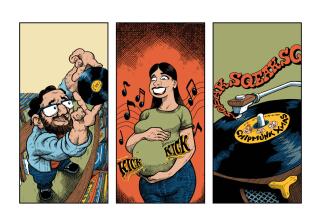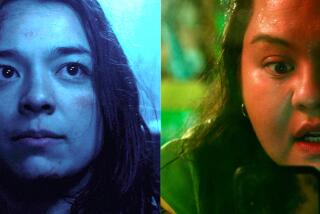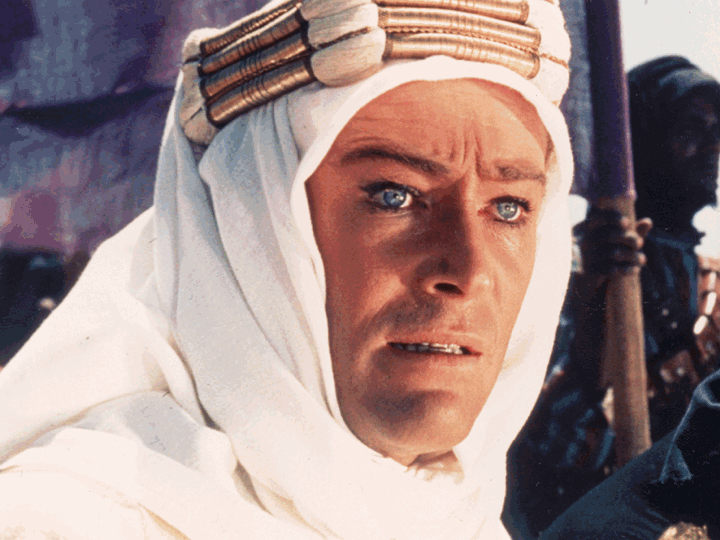Recordable CD Crams Lots of Music on a Tiny Disc
The recordable CD will finally be available this fall, just in time for the Christmas shopping season, from Sony. But will it be usable on the standard, playback-only CD machine?
Of course not.
The introduction of new audio and video formats usually means buying new hardware and new software, and Sony’s Mini Disc, or MD, is no exception.
Encased in a cover, the MD, which is just 2.5 inches in diameter, fits a palm-sized player, remarkably playing up to 74 minutes of music, with instant random access to any selection. The sound is so near CD quality that only purists can tell the difference. To copy CDs, merely hook the recorder/player to your stereo system.
The MD is based on data compression technology. To cram all that music on that little disc, sounds that the human ear can’t hear are eliminated, which isn’t likely to bother the average listener but has rankled purists.
“The average person won’t be able to tell the difference in the MD and the CD,” insisted Michael Vitelli, the senior vice president and general manager of Sony’s personal audio products division.
Aside from recordability, the MD’s main asset is that the machines don’t skip--unlike portable CD players. A computer chip with enormous storage capabilities virtually eliminates the laser mistracking on MD units.
Prices haven’t been determined yet, but Vitelli provided some rough estimates: $500 to $800 for a recorder/player, though likely closer to $500; a machine capable of playback only will cost less; $12 for a blank disc. He didn’t speculate on the cost of prerecorded software but other sources have placed it at $12 to $16.
Initially, Sony will launch the format with portable models, though as of yet, the company hasn’t settled on which one.
“The first model will be a portable record/playback machine, basically a Mini Disc Walkman that records,” said Vitelli. “The MD is applicable to all configurations, like car audio, the boombox, the home deck, mini component stereos. It can be anything. But which other models will be available at the initial launch hasn’t yet been determined.”
Why Sony’s emphasis on the portables market?
“It’s such a potential growth area and such a major part of the music business,” Vitelli replied. “People love CDs and want to be able to carry that sound with them. There’s an untapped market for portable, digital-quality sound. The Mini Disc fits the needs of that market because of its small size and its shock-resistant quality.”
Sony started displaying MD prototypes last year, providing some demonstrations for the consumer electronics media. The word was that it would be available in 1993, to avoid clashing with Philips’ new digital compact cassette (DCC) format, due for a launch this fall. But apparently Sony decided to introduce the MD this fall too, feeling that waiting another year might have given the DCC, which plays both a digital tape and standard tape, a chance to get a foothold.
Vitelli, though, stressed that Sony’s decision for a fall launch had nothing to do with the DCC. “Our product planning isn’t reactionary in any way,” he said.
The MD units come equipped with the standard copy protection--Serial Copy Management System (SCMS)--which allow you to make as many copies as you want. However, those copies are recorded in such a way that they can’t be used to make further copies.
The launch of the MD will create some problems. For instance, retailers are trying to figure out how to package and display such a small disc. Also, there’s some concern in the industry that if the MD catches on, it may stunt the growth of CDs, currently at 32% market penetration. That concern may translate into lack of support.
Vitelli, though, insisted the MD is no threat to the CD market. “You’ll see that the MD and the CD can coexist,” he said. “The CD format is much cheaper and will continue to grow while the MD is establishing itself in the market.”
What’s New in Video: Here are some recent video releases:
“101 Dalmatians” (Disney, $25). This 1961 film, arguably the most homey and heartwarming of all the Disney feature-length cartoons, details the adventures of Dalmatians Pongo and Perdita who battle villainous Cruella De Vil, a fur fancier who steals their puppies to get fur for a coat.
“The Last Boy Scout” (Warner, $95). In this bloody buddy movie, featuring spectacular action sequences and minimal character development, a cynical ex-Secret Service agent (Bruce Willis) and a cokehead ex-quarterback (Damon Wayans) join forces against corrupt leaders in L.A.’s political and football circles.
“Shattered” (MGM/UA, $95). An absorbing thriller burdened with a far-fetched finale, it stars Tom Berenger as a rich amnesiac trying to uncover his past with the help of a detective (Bob Hoskins), while dealing with a devious wife (Greta Scacchi).
“Necessary Roughness” (Paramount, no retail price). Sporadically funny, low-brow college football comedy about a Texas university, on probation for violations, rebuilding its team with a clean-cut coach (Hector Elizondo) and non-scholarship recruits, including a chemistry prof (Sinbad) and a thirtysomething quarterback (Scott Bakula).
“Ricochet” (HBO, $95). A police thriller, trashed by most critics, about a serial killer (John Lithgow) out for revenge against the man (Denzel Washington) who put him in jail. Ice-T co-stars.
“Singin’ in the Rain” (MGM/UA, $20). In this 1952 film, arguably the best movie musical ever, Gene Kelly, Debbie Reynolds and Donald O’Connor cavort in late-’20s Hollywood, when talkies were replacing the silents. This is a 40th anniversary edition, offering a remastered print, which produces a sharper, clearer picture, as well as extras like the original trailer, reminiscences about the filming and a sequence in which Reynolds sings “You Are My Lucky Star.”
“The Very Best of the Ed Sullivan Show” (Buena Vista, $20 per tape). Two near-100-minute volumes of fascinating highlights--”Unforgettable Performances” and “Greatest Entertainers”--from Sullivan’s TV variety show that ran from 1948-71. Works as nostalgia, camp or simply as a sampling of the wide range of entertainment of that era--from comics to circus acts to greats like Elvis Presley, the Beatles, Judy Garland and a very young Mick Jagger singing “Satisfaction.” Only gripe: Director/co-writer Andrew Solt tried to include so much that many sequences are too short and some are just bits.
Upcoming on Video: Disney recently announced that “Beauty and the Beast,” the first animated feature to be nominated for a best picture Oscar, will be out on home video Oct. 30, at $25. Because it is the highest-grossing animated film ever--$128 million and climbing--some industry observers speculate that it will easily break the all-time unit sales mark--currently held by another Disney cartoon, “Fantasia,” at 14.2 million.
Other best picture Oscar nominees will debut on home video sooner, including Oliver Stone’s “JFK,” which will be released in a double-cassette package by Warner on May 20.
Already scheduled for June: MCA/Universal’s “Cape Fear,” Paramount’s “The Addams Family,” FoxVideo’s “Grand Canyon” and Touchstone’s “Father of the Bride.” Another likely June release: Columbia TriStar’s “Bugsy.”
Next week: Jodie Foster’s “Little Man Tate” and “My Own Private Idaho” on Wednesday and “The People Under the Stairs” on Thursday.
New on Laser: Recent releases on laser disc include:
“Lullaby of Broadway” (Warner/Pioneer, $35). This 1951 musical about the adventures of a musical comedy star (Doris Day) in New York is a bit corny but features some excellent numbers.
“Party Girl” (MGM/UA, $35). This fascinating 1958 hybrid, part gangster movie and part musical, is about a mob lawyer (Robert Taylor) who tries to go straight, aided by a showgirl (Cyd Charisse).
“Out of the Past” (Image, $50). 1947 film noir classic, starring Robert Mitchum and Jane Greer, with audio track by film historian David Thomsom.


